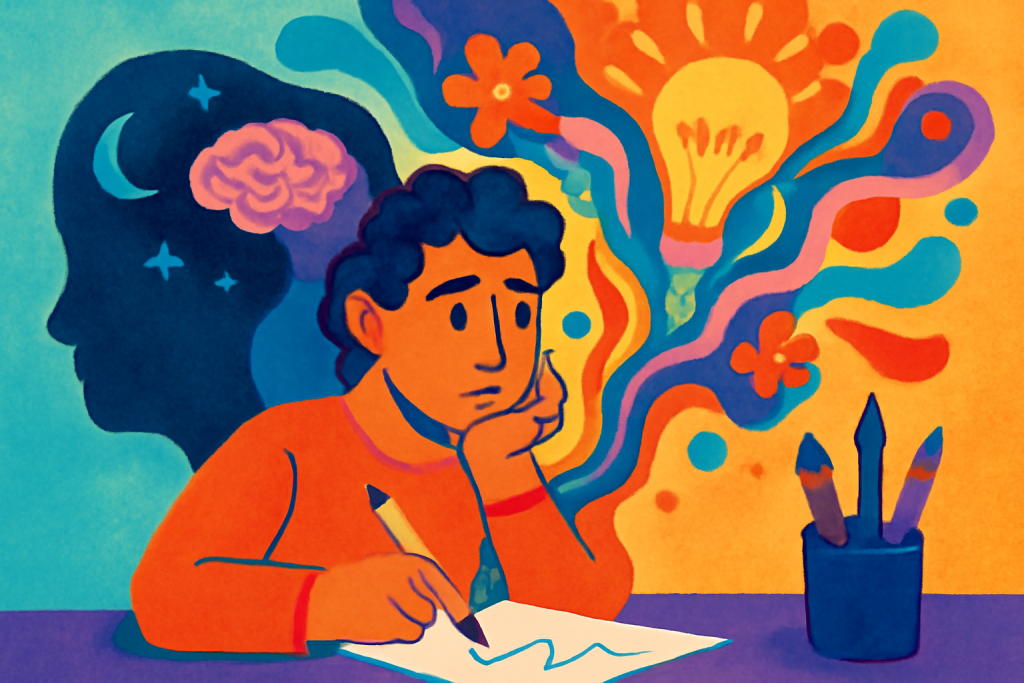Creativity and mental health have long been subjects of fascination, both in scientific research and popular culture. Many wonder if being creative influences mental well-being or vice versa. Understanding the link between creativity and mental health can not only shed light on how our minds work but also offer practical ways to enhance emotional resilience and personal growth.
This article explores the complex relationship between creativity and mental health, backed by research and expert insights. Whether you’re an artist, professional, or simply curious, these insights can help you harness creativity for better mental wellness.

What Is Creativity? Understanding Its Many Forms
Creativity isn’t limited to art or music. It is the ability to generate new ideas, solve problems in novel ways, and express oneself uniquely. It can appear in writing, cooking, problem-solving, innovation, or everyday life.
Different Types of Creativity:
- Artistic Creativity: Painting, drawing, music, dance
- Scientific Creativity: Innovation, research, invention
- Everyday Creativity: Problem-solving, cooking, gardening
Understanding creativity broadly helps recognize how it impacts mental health in various ways.
The Scientific Link Between Creativity and Mental Health
Several studies have investigated the connection between creativity and mental health, revealing nuanced findings:
- Higher Creativity and Mental Health Challenges: Research shows that creative individuals may have a higher incidence of mood disorders, anxiety, or bipolar disorder (Kyaga et al., 2011). However, this does not imply causation but suggests a complex relationship.
- Creativity as a Coping Mechanism: Creativity often serves as an outlet to process emotions and trauma. Engaging in creative activities can reduce stress, anxiety, and depression symptoms (Stuckey & Nobel, 2010).
- Positive Effects on Brain Function: Creative expression stimulates the brain, improving neuroplasticity, which is crucial for mental health recovery and resilience (Lubart, 2001).
How Creativity Can Improve Mental Health: Practical Insights
1. Emotional Expression and Release
Creative activities like writing, painting, or music help externalize feelings, making them easier to understand and manage.
- Journaling can clarify emotions and reduce rumination.
- Artistic creation provides a non-verbal outlet for complex feelings.
2. Boosting Mood and Reducing Stress
Engaging in creative hobbies triggers dopamine release—the brain’s “feel-good” chemical.
- Regular creative practice improves overall mood.
- Crafting or music sessions lower cortisol, the stress hormone.
3. Enhancing Mindfulness and Presence
Creative processes require focus, which promotes mindfulness—being fully present.
- Activities like sculpting or drawing help quiet the mind.
- Mindfulness is linked to reduced anxiety and better mental health.
Creativity and Mental Health in Daily Life: Tips to Get Started
If you want to use creativity as a tool for mental wellness, try these easy ways:
- Start a Daily Journal: Even a few minutes of writing thoughts or gratitude.
- Try Simple Art Projects: Sketch, color, or collage with no pressure for perfection.
- Cook or Bake Creatively: Experimenting in the kitchen can be relaxing and rewarding.
- Explore Music: Listening to or creating music can soothe and energize.
- Practice Mindful Crafting: Activities like knitting or gardening build focus and calm.
Addressing Misconceptions: Creativity Does Not Cause Mental Illness
While creative people sometimes report mental health struggles, creativity itself is not the cause. Instead, creativity can be a powerful ally in managing mental health, offering meaning and hope.
If you experience mental health challenges, seek professional help. Creativity complements, but does not replace, treatment.
Emerging Trends: Technology, Creativity, and Mental Health
Technology offers new ways to engage creativity for mental health:
- Creative Apps: Platforms for digital art, music production, and writing make creativity accessible.
- Online Communities: Sharing creative work builds connection and support.
- Virtual Reality Therapy: Using immersive environments for creative expression and healing.
Final Thoughts: Embrace Creativity for Better Mental Health
Exploring the link between creativity and mental health reveals a rich, supportive relationship. By engaging your creative side, you can enhance emotional awareness, reduce stress, and boost resilience.
Make creativity a regular part of your life—not just as a hobby, but as a path to greater well-being.
References
- Kyaga, S., et al. (2011). Creativity and mental disorder: family study of 300,000 people with severe mental disorder. The British Journal of Psychiatry.
- Stuckey, H. L., & Nobel, J. (2010). The Connection Between Art, Healing, and Public Health: A Review of Current Literature. American Journal of Public Health.
- Lubart, T. I. (2001). Models of the creative process: Past, present and future. Creativity Research Journal.






